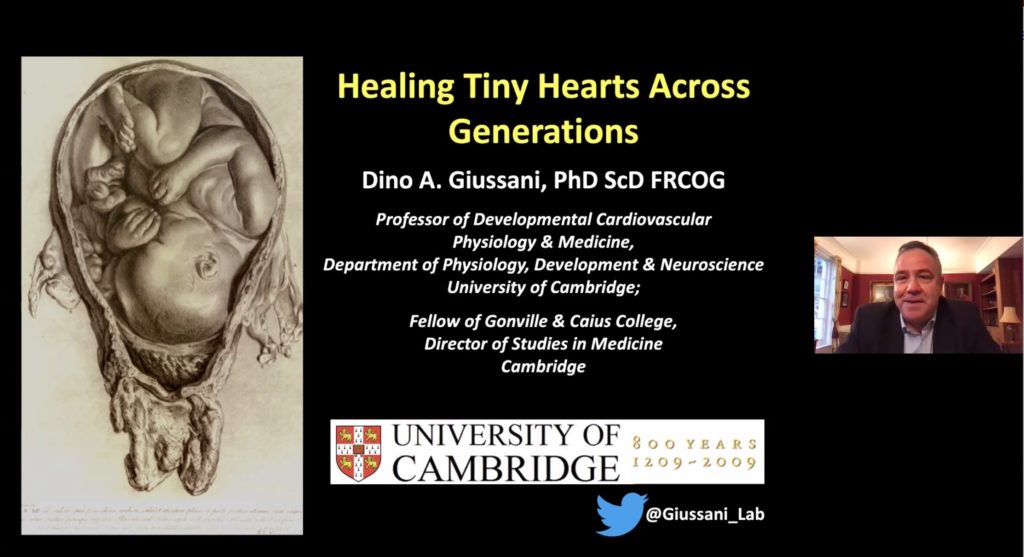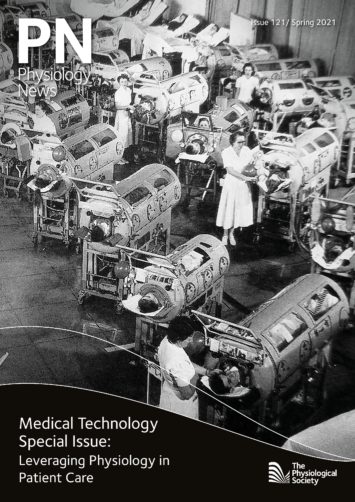
Physiology News Magazine
GL Brown Prize Lecture: Healing Tiny Hearts Across Generations
Events
GL Brown Prize Lecture: Healing Tiny Hearts Across Generations
Events
Nitika Gupta, University of Liverpool, UK
https://doi.org/10.36866/pn.121.33
On 3 December 2020, The Physiological Society hosted this year’s GL Brown Prize Lecture. The award honours the late Professor Sir Lindor Brown, who was a scientist known not only for his important contributions to the field of physiology, but also for his enthusiasm in encouraging and nurturing the next generation of scientific researchers.
This year’s awardee was Professor Dino Giussani from the University of Cambridge, UK, who specialises in developmental cardiovascular physiology. As a PhD student investigating genetic cardiac diseases, I was excited to attend his talk, “Healing Tiny Hearts Across Generations”; I was particularly interested in learning more about the mechanism behind the programming of cardiovascular disease in a developing fetus, and the multi-generational consequences of this.
Professor Giussani and his group investigate the effects of exposure to hypoxia during foetal development on cardiovascular health in adulthood. Foetal hypoxia can be caused by common pregnancy complications such as pre-eclampsia and gestational diabetes (which affect 6% and 16% of pregnancies in the UK, respectively), and has been shown to lead to changes in the adult cardiovascular system that increase the risk of disease. According to the British Heart Foundation, 1 in 3 people in the UK suffer from some form of cardiovascular condition, so viable approaches to reduce the risk of predisposition to disease will have a great impact on the health of the general population.

Professor Giussani demonstrated how hypoxia in the later stages of pregnancy led to disease-associated phenotypes such as foetal growth restriction, increased mean arterial blood pressure and left ventricular hypertrophy. The underlying pathophysiology of these traits were shown to be linked to oxidative stress. Remarkably, these negative outcomes were significantly reversed by the administration of a mitochondrial-targeted antioxidant, MitoQ. The therapeutic potential of MitoQ or related drugs as an intervention to either prevent or limit the damaging effects of hypoxia at this crucial early stage of development could, therefore, have massive implications for the health of these individuals later in life.
The second half of the lecture focused on the so-called “100-year effect,” the idea that cardiovascular traits programmed in the developing fetus can be transmitted to subsequent generations. To investigate this, Professor Giussani’s team isolated hearts from adult rats who experienced hypoxia in utero (F1 generation), and their offspring (F2 generation). By controlling the perfusion of these hearts, they were able to mimic and then measure the recovery from ischaemia, as an indicator of cardiac health. As predicted, F1 males displayed a slower recovery compared with those who were not exposed to foetal hypoxia. However, this slower recovery was also observed in F2 males with a paternal history of foetal hypoxia, suggesting a possible paternal inheritance of disease programming. In addition to this, Professor Giussani showed that cardioprotective traits mediated by mitochondrial function are developed in F1 males in response to foetal hypoxia, and are only passed down to the F2 generation via the maternal line.
These opposing patterns of either beneficial or detrimental trait transmission, possibly linked to epigenetic inheritance, raise many questions regarding the underlying mechanisms at play. For example, Professor Giussani found that the cardioprotective effect involved reduced protein kinase C-ε expression, which modulates mitochondrial processes and interacts with cardiac contractile machinery; this is also seen in ischaemic preconditioning. It would be interesting to see if there are further similarities or interaction with other cardioprotective mechanisms. I am also curious to see if F1 and F2 females demonstrated a similar pattern of trait inheritance, as there is research to suggest that female rodents have some inherent cardioprotection, due to factors such as differential KATP channel expression.
I really enjoyed listening to Professor Giussani’s talk. As someone who uses primarily in vitro techniques, I learnt a lot about the uses of different animal in vivo and ex vivo models relevant to foetal development. But perhaps more importantly, following the journey of his research gave me a greater appreciation of the significance of multi-disciplinary collaboration to gain a more cohesive understanding, from molecular mechanism through to therapeutic intervention.
I’m sure the other attendees would have agreed with the chair, Professor Colin Sibley, who said that Professor Giussani’s own invigorating personality, in addition to his academic work, made him a fitting recipient for this year’s award. His warmth, good humour and enthusiasm for research was evident throughout the talk, as well as when responding to the sheer volume of questions submitted, many of which were from undergraduates. This really embodies the spirit of the GL Brown Prize in his desire and success in engaging young physiologists not only from the UK but also around the world.
Whilst it is uncertain when Professor Giussani will be able to share his lecture in person again (thank you, COVID-19), I look forward to hopefully meeting him in person in the future. In the meantime, I highly recommend watching his talk, which is available on YouTube www.physoc.org/ events/healing-tiny-hearts-across-generations/, presenting innovative physiological research in a way that is more accessible to early career scientists and the wider global scientific community.
